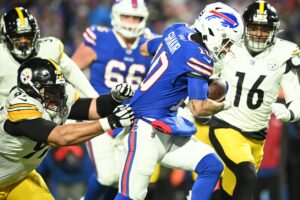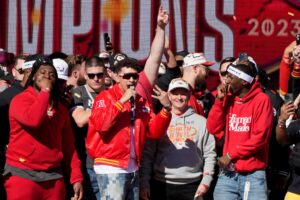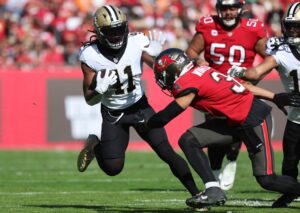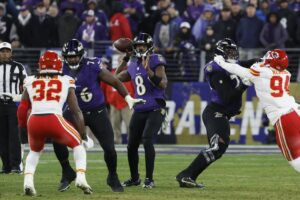During the month of August, the Last Word On Sports NFL department will be breaking down every division in the league by position. This article contains a position-by-position breakdown of the NFC South offenses. The breakdown will contain “the best” at each unit followed by “the rest” in descending order.
2018 NFC South Breakdown by Position: The Offense
Quarterback
The Best: New Orleans Saints
The Rest: Atlanta Falcons, Carolina Panthers, Tampa Bay Buccaneers
What makes the NFC South the league’s best division is the upper-echelon quarterback play, and Drew Brees is once again the Southern’s finest. Though enduring a two-year hiatus from the division’s top spot (thanks to MVPs Cam Newton and Matt Ryan), Brees continues to produce at a highly-efficient level from the pocket. While he wasn’t his usual 5,000-yard passing self in 2017, the perennial Pro Bowl passer once again set the NFL’s single-season record for completion percentage (72.0). His 4,334 yards and 23 touchdowns a year ago are both his fewest marks as a Saint, but he delivered through the air whenever called upon. Only one play away from the NFC Championship Game, Brees is once again in contention for another Super Bowl title. Although New Orleans has an elite rushing duo and a vastly-improved defensive unit, the franchise needs its all-time greatest player more than ever in 2018.
Notwithstanding a statistical regression under new offensive coordinator Steve Sarkisian, Matt Ryan is still one of the game’s premier passers. While his touchdown total (20) was his lowest since his rookie year, Ryan still passed for more than 4,000 yards and completed 65 percent of his attempts. Throughout his 11-year career, the Boston College product has been deemed “overrated” by critics for the number of weapons he’s enjoyed. Regardless of the arsenal, those claims are far from the truth. Following Michael Vick dogfighting fiasco and Bobby Petrino’s in-season resignation, Ryan has greatly stabilized the Falcons franchise. Since 2008, he’s made the Pro Bowl under three different offensive coordinators, not to mention both of his head coaches being defensive-minded. Primed for a Super Bowl run in their home stadium, Atlanta will go as Ryan goes.
Kelvin Benjamin strongly disagrees with this, but Cam Newton is a high-quality quarterback in the National Football League. His 3,302 passing yards in 2017 were a dip from 2016, but he improved in touchdowns passes (22) and passer rating (80.7). Newton remains distant from his outlier MVP campaign, yet he continues to be the do-everything player for the Panthers. Despite not having Pro Bowl tight end Greg Olsen for a stretch and still lacking top-end receiver play, he always has his team in contention to win games. The 349-yard, two-touchdown performance against the Saints in last year’s Wild Card game was one of his greatest career outings. If he remains consistent, the sport’s most physically-gifted passer can continue to surge upward.
In a division that consists of Brees, Ryan and Newton, Jameis Winston will perennially place last in the NFC South quarterback rankings. After fulfilling a career year across the board in 2016, Winston regressed to personal lows for yards (3,504) and touchdowns (19) in 13 starts. Entering a crucial 2018 in catch-up mode with his three-game suspension looming, the former Heisman Trophy winner must excel beyond measure in his return to not risk losing his starting job. While he has immense ability, every snap for him matters moving forward.
Running Back
The Best: New Orleans Saints
The Rest: Atlanta Falcons, Carolina Panthers, Tampa Bay Buccaneers
After the Monday Night stare down debacle with Adrian Peterson and Sean Payton, the Saints began to quickly regret the off-season acquisition of the future Hall of Fame rusher. Once they shipped Peterson to the Arizona Cardinals and featured rookie Alvin Kamara more, the team’s season drastically changed. A once-ominous campaign turned into playoff contention when Kamara and Mark Ingram carried the Saints to an eight-game winning streak via the ground game. The tandem was so dominant in 2017 that they became the first pair of running backs in NFL history to each accumulate 1,500-plus scrimmage yards in a single season. It hasn’t been since Deuce McAllister that a New Orleans opponent had to primarily stop the run. Even though any chance the Saints have at a championship dies without Drew Brees, Kamara and Ingram are extremely vital to their offense. Once Ingram returns from his four-game suspension, the backs should continue to build on last year’s success.
As the NFL’s darling backfield in 2016, Devonta Freeman and Tevin Coleman took a backseat to the Saints’ record-breaking running duo a season ago. Despite not receiving the same adoration, Freeman rushed for 865 yards and seven touchdowns in 14 starts. Although he only started three contests in 2017, Coleman set a career mark in rushing yards with 628 to complement his five scores on the ground. With both rushers having the capability to run and receive when called up, neither have glaring weaknesses in their respective games. Another team situation where the absence of the quarterback would derail any title hopes, Freeman and Coleman make Ryan’s load considerably lighter.
With a historic rookie running back class that featured Alvin Kamara, Kareem Hunt, Leonard Fournette, Joe Mixon and Dalvin Cook, Christian McCaffrey was vastly underrated. Only putting forth 435 yards and two scores on the ground, the Stanford All-American made a significant impact receiving. The former Heisman Trophy finalist quietly tallied 80 receptions in 2017, surpassing Kelvin Benjamin’s Panthers rookie record of 74 in 2014. Before Kamara joined him late last year, McCaffrey was the only first-year rusher in league history to record at least 70 receptions and five touchdown catches. His versatility is consistently needed given the team’s lack of formidable pass catching. Coming off a 1,000-yard campaign with the Denver Broncos, C.J. Anderson should further bolster the Panther backfield.
After Doug Martin failed to remain healthy, the Buccaneers chose to move on with third-year runner Peyton Barber. Combining for 646 yards and four touchdowns in his first two seasons, Barber will be given the responsibility to revitalize the Buccaneers suffering rushing attack. With 804 yards in that same time span, eight-year veteran Jacquizz Rodgers is still there to pitch in. Grabbed in the second round from USC, rookie Ronald Jones should also contribute periodically.
Wide Receiver
The Best: Atlanta Falcons
The Rest: New Orleans Saints, Tampa Bay Buccaneers, Carolina Panthers
Taylor Gabriel signed with the Chicago Bears in Free Agency, but Atlanta still has the South’s best receiving corps. Of course, the group is led by Julio Jones. Posting at least 80 receptions for 1,400 yards for the fourth-consecutive season, Jones continues to show that he’s arguably the league’s top wideout. His deadly combination of size and speed makes him virtually impossible to cover. Despite the Falcons offense taking a step backward in 2017, Jones actually improved on his 2016 totals. Receiving the team’s pass-catching torch from Roddy White and Tony Gonzalez, the perennial All-Pro catcher has proved to be more than able to carry the receiving burden. Hauling in 177 grabs for 1,793 yards and nine touchdowns since 2016, former Cincinnati Bengals receiver Mohamed Sanu is a respectable second option for Matt Ryan. Both guys should help rookie Calvin Ridley‘s transition into the professional ranks much smoother. Putting up solid numbers at the University of Alabama, his route running and quickness are attributes the Falcons will exploit.
For the first time since 2005, the New Orleans Saints will enter an NFL season with a Pro Bowl wide receiver. After making 92 catches as a rookie, Michael Thomas set a franchise single-season record with 104 receptions to go along with his career-best 1,245 receiving yards. The former Ohio State Buckeye also broke Jarvis Landry‘s NFL record for most receptions by a player in his first two seasons (196). Only entering year three, he’s establishing himself as an elite target. Outside of Thomas, the Saints have talented question marks throughout their crop of wideouts. Despite his 700-yard production and explosiveness, Ted Ginn is 33 years old. Cameron Meredith from Chicago was a great get for New Orleans, but he’s coming off an injury that stole his entire 2017 season. To strengthen depth, the team drafted UCF’s Tre’Quan Smith in the third round. Drew Brees easily elevates his supporting cast, but with him turning 40 this season and the running game becoming more of the offensive focus, it’ll be interesting to see how this receiver corps delivers in the foreseeable future.
Though gifted on paper, Tampa Bay’s top two receivers leave more to be desired. Setting career highs in receptions (96), yards (1,321) and touchdowns (12) in 2016, Mike Evans faltered last year in each category. Being a Pro Bowler, he does have the skills to recover. Joining the roster in 2017, veteran DeSean Jackson‘s 50 catches for 668 yards and three scores was his worst stat line in a season with at least 13 starts since his rookie year. Playing in 2018 at age 32 may not bode well for the once-electrifying gamebreaker. The best-case scenario for the Bucs would be for Adam Humphries and Chris Godwin to continue to emerge in the offense.
Cam Newton gets grief for his inconsistencies, but he should be greatly commended for making use of an annually-underwhelming receiver bunch. After the departure of Steve Smith following the 2013 campaign, the Panthers have struggled to find a top-flight pass catcher. Despite his physical gifts, Kelvin Benjamin was ultimately a failure. Devin Funchess is a quality player who had personal bests across the board in his first year as a full-time starter. After Funchess, there’s Torrey Smith, who hasn’t surpassed the 50-catch plateau since 2013. Though he’s only a rookie, first-round draftee D.J. Moore from the University of Maryland must use his run-after-catch prowess to help bolster Carolina’s passing game.
Tight End
The Best: Carolina Panthers
The Rest: Tampa Bay Buccaneers, Atlanta Falcons, New Orleans Saints
Though Tampa has the best depth at the position, Carolina still has the division’s best tight end in Greg Olsen. Enduring a slow beginning to his professional career with the Chicago Bears, Olsen has developed into one of the league’s biggest late bloomers in recent memory. Not including last season due to injury, the former Miami Hurricane boasted five straight seasons with at least 60 catches and 800 yards. With a subpar collection of wide receivers, Olsen has been the unquestioned security blanket for Cam Newton since Steve Smith’s exodus in the 2014 off-season.
With the wide receivers having a down year, the Tampa tight ends surged upward in 2017. Despite only starting six games, Cameron Brate had 591 yards and six touchdowns on 48 receptions. Though never being a full-time starter, the 27-year-old’s 17 career touchdowns make him somewhat of a scoring machine. His rookie running mate from Alabama, O.J. Howard, also found the endzone on six different occasions. With Greg Olsen being 33, competent quarterback play will soon give the Bucs the division’s best tight end situation.
Several years removed from Tony Gonzalez, Atlanta hasn’t heavily prioritized the tight end spot. That said, third-year pass catcher Austin Hooper is looking to be a dependable player in the middle of the field. Setting personal bests in catches (49), yards (526) and touchdowns (three), the 24-year-old should capitalize with the presences of Julio Jones, Mohamed Sanu and Calvin Ridley around him.
Four years after the Jimmy Graham era, the Saints have yet to fully replace the dominance of their former All-Pro seam surgeon. After neglecting the position in the draft, the team opted for Benjamin Watson. The longtime veteran did enjoy a career year for New Orleans back in 2015, but he’s an aging player, nonetheless. Far and away their weakest offensive position, the Saints much readdress this once-excellent area of the field sooner rather than later.
Offensive Line
The Best: New Orleans Saints
The Rest: Atlanta Falcons, Carolina Panthers, Tampa Bay Buccaneers
Despite anchoring the league’s fifth-best rushing attack and only surrendering 20 sacks in 2017, the New Orleans Saints offensive line is vastly underrated. Even with paving the way for an historically-great backfield and once again protecting Drew Brees, only one Saints lineman was selected to the Pro Bowl; that being right guard Larry Warford, as only an alternate. Rookie Ryan Ramczyk was the biggest snub of the unit as he replaced Zach Strief at right tackle. In year three, Andrus Peat found a home at left guard. Going into his fourth season with the team, center Max Unger remains a dependable interior blocker. If Terron Armstead can stay healthy, there aren’t many front fives that match New Orleans position for position.
Right behind Saints in the sacks allowed category is the Atlanta Falcons frontline. Surrendering only 24 takedowns in 2017, Matt Ryan was kept pretty clean throughout the season. The unit is led by center Alex Mack, who made the Pro Bowl in each of his first two seasons in Atlanta. The 2016 acquisition of the perennial Pro Bowler was an integral piece to the team’s historic offensive campaign two years ago. Outside of the stellar pass protection, the best trait of Atlanta’s line is its continuity. Joining the Falcons in 2013, right tackle Ryan Schraeder has started 60 of 72 regular season battles. Drafted one year later, left tackle Jake Matthews has only missed one game. Out of 48 possible regular season games, left guard Andy Levitre has started 45 since coming from the Buffalo Bills in 2015. Starting every game last year, right guard Wes Schweitzer is on a similar track of stability. Though not as talented or overwhelming as the Dallas Cowboys‘ front at full strength, one can count on Atlanta’s starting five to always be healthy and ready to play.
After the Saints and Falcons, there’s a steep dropoff to the Panthers. Though the 35 sacks the group allowed were middle of the road a season ago, that amount is concerning, especially for a team that has a quarterback who supplies in the running game. Matters will be more arduous now that First-team All-Pro guard Andrew Norwell is with the Jacksonville Jaguars. Though their fortunate to still have their usual Pro Bowlers Ryan Kalil and Trai Turner, the line’s overall performance must improve to maintain the health of Cam Newton.
Once again, Tampa Bay finishes last at an offensive position. Exceeding Carolina’s sack-surrendered total with 40, the Buccaneers also gave up the tenth-most quarterback hits in the league last season (100). With the ground game being worse, the franchise ranked 27th in rushing for the 2017 season. While they do have familiar faces in Ali Marpet, Donovan Smith and Demar Dotson, Smith was the only player of the trio to start all 16 games a year ago. Starting only six games his first two seasons as a pro, Caleb Benenoch must mature quickly as a blocker. Following up a 16-start campaign for the Baltimore Ravens, Tampa should hope that center Ryan Jensen will bring that reliable momentum to this new front five.
Check out the NFC South defensive breakdown.
Main Photo:
Embed from Getty Images






